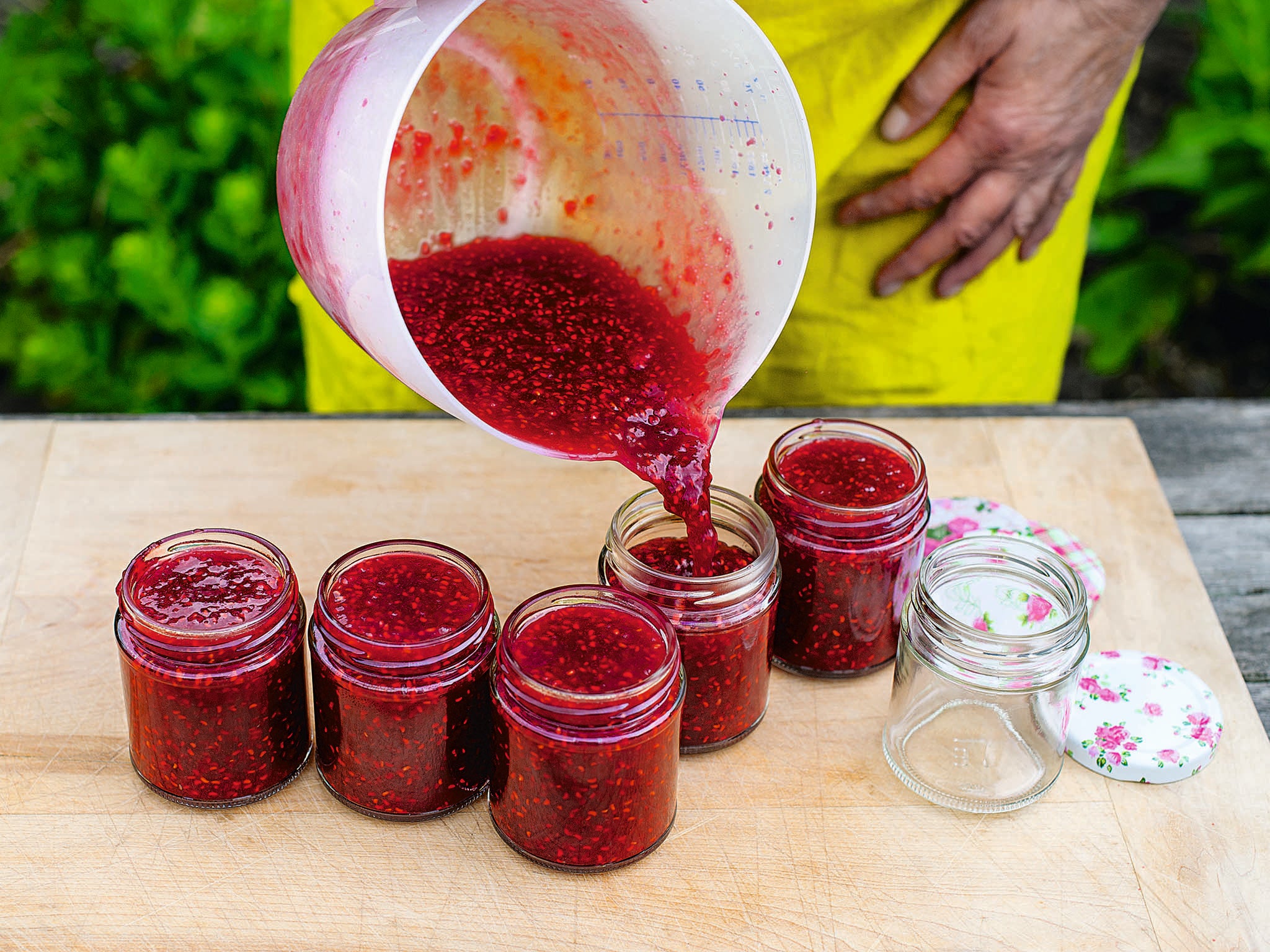'Pam the Jam' cookbook: How to make the best raspberry jam and elderflower vinegar
Known as the master of preserves, Pam Corbin is the go-to woman for everything from jellies to marmalades. Here she shares her secrets

Best ever raspberry jam
Here’s my favourite jam. Of course I love all the jams in the book but I make this one most often – it’s super-easy, quick, highly fruity (about 80 per cent fruit) and as reliable as the sun rising. Using jam sugar, which has had pectin added to it, means you get a good set without overcooking the raspberries and reducing them to a mass of woody pips.
Sometimes I replace 50g of the jam sugar with coconut sugar (made from the sap of the coconut palm) to add another level of flavour to this already gorgeous panful. Or you can fortify the jam by stirring in 50ml gin as soon as it reaches setting point and has been removed from the heat.
Raspberries are in season from June to October. If you miss the raspberry season, then look out for frozen raspberries; they work just as well and you can use them straight from the freezer.
Makes 6 × 200ml jars
1kg raspberries
650g jam sugar (ie with added pectin)
A drop or two of olive oil (if needed)
Sterilise your jars and twist-on lids. Put the raspberries in a large heavy-based pan or preserving pan. Lightly sprinkle in the sugar, a third at a time, gently shaking the pan so the sugar is well distributed. Cover and leave for an hour or so for the juices to draw out.
Lightly stir the mixture with a wooden spoon to break up any clumps of sugar. Place over a medium heat and bring to a steady boil, then boil for 5-6 minutes for a soft set jam, or 7-8 minutes for a firmer set. If you want to be sure, you can test for setting point by using the gel test.
Remove from the heat and stir lightly (in one direction only) to remove any foam, adding a drop or two of oil if it doesn’t dispel easily. Tip into a wide-necked jug with a good pouring lip, then fill the warm sterilised jars to the brim. Seal at once.
Invert each jar for a minute or so, to ensure the lid is sterilised, then turn the right way up and leave to cool. Store in a cool, dark, dry place. Best eaten within nine months. Keep in the fridge once opened and eat within 4-6 weeks.
Spin-off: Easy trifle
Halve six rectangular trifle sponges horizontally. Spread one half of each generously with raspberry jam then sandwich together with the other half.
Wedge the trifle sponges across the base of a serving dish and douse with 100ml sherry.
Scatter with 200g fresh raspberries and 25g toasted flaked almonds. Cover with 500ml shop-bought or homemade vanilla custard.
Whip 250ml double cream with 1 or 2tbsp of caster sugar until thick, then spread this over the custard. Decorate with toasted flaked almonds. Serves 4-6.
Elderflower vinegar
This aromatic elderflower vinegar is an excellent way to bring a summery breeze to your salad dressings – either the vinaigrette kind or the mayonnaisey sort. You can replace some or all of the vinegar in a pickling recipe with it too; elderflower vinegar is particularly good for pickling cucumbers.
If you feel like having a go with other edible flowers, simply stick to the same quantities – 50g edible flowers for every 500ml vinegar – making sure they are safe to eat and haven’t been sprayed with pesticide. For lavender vinegar, I like to add a few lightly crushed black peppercorns and some pared lemon zest. If using roses, make sure they are fragrant and replace the sugar with honey.
Instead of (or as well as) labelling the bottle of vinegar, you might put a sprig of the flower in before sealing, as a way to identify the contents.
Makes 1 × 500ml bottle
50g elderflower heads, plus a sprig for the bottle
50g granulated sugar, to taste
500ml white wine vinegar
Shake the elderflower heads to get rid of any insects and trim off any woody stalks. Pack into a spotlessly clean, sealable 500ml jar.
Add the sugar to the jar, then pour in the vinegar. Give the jar a good shake and leave on a sunny windowsill for 2-3 weeks to infuse.
Strain out the flowers and pour into a clean bottle. Add a fresh sprig of elderflower to the bottle, if you like. Seal with a vinegar-proof lid or cork. The vinegar will keep for 12 months in a cool, dark, dry place.
Variation: Herb vinegar
You can either use a single herb or a mixture of whatever is to hand.
I’d recommend using cider vinegar for more pungent herbs such as rosemary and mint, and white wine vinegar for herbs with a more subtle fragrance, such as parsley, tarragon and nasturtium flowers (or their seed pods).
Allow 50g herbs for 500ml vinegar. Crush the herb leaves and stalks to release their essence and aroma.
Then pack them in a clean, sealable 1-litre jar with the vinegar, plus 1tsp salt and 2-3tbsp of granulated sugar (or to taste), and leave to infuse for a couple of weeks.
Strain out the herbs and pour into a clean bottle, along with a fresh sprig of the herb, if you like.
‘Pam The Jam: The Book of Preserves’ by Pam Corbin (Bloomsbury, £20) Photography © Mark Diacono
Subscribe to Independent Premium to bookmark this article
Want to bookmark your favourite articles and stories to read or reference later? Start your Independent Premium subscription today.

Join our commenting forum
Join thought-provoking conversations, follow other Independent readers and see their replies